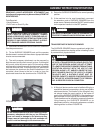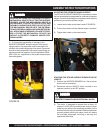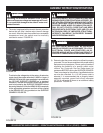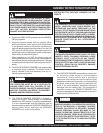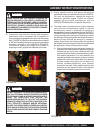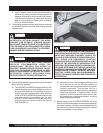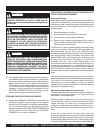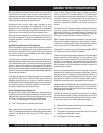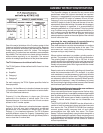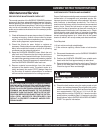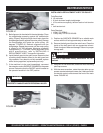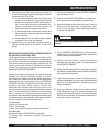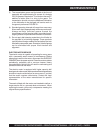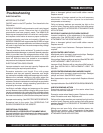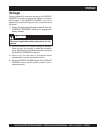
SFG10E ELECTRIC SURFACE GRINDER — OPERATION AND PARTS MANUAL — REV. #1 (07/16/07) — PAGE 30
FIGURE 40
One of the major limitations of the F number system is that
it does not control the surface regularity at joints. Because
joints are statistical anomalies, the standard test method
forbids measurements within 24 inches. The designer
specifying by F number has two methods to accommodate
the problem. The first solution is to locate joints at locations
where surface regularity is not important. The second
solution is to design specifications for the joints themselves.
The TR 34 tolerances for defined traffic floors
The TR 34 System divides defined traffic floors into three
categories:
a) Superflat
b) Category 1
c) Category 2
For each category, the TR 34 System specifies limits for
three properties:
Property 1 is the difference in elevation between two points
12 inches apart, measured in the direction of vehicle traffic.
This is the levelness tolerance.
Property 2 is the difference in slope over 24 inches
measured in the direction of vehicle traffic. This is the
flatness tolerance. It is identical as the 24 inch curvature
utilized in the F number system.
Property 3 is the difference in elevation between opposite
points in the left and right wheel path, measured
perpendicular to the direction of vehicle traffic. As with
Property 1, it is a levelness tolerance. The TR 34 System
specifies different values for Property 3 depending upon
whether the distance between left and right wheel paths is
more or less than 5 nominal feet
ASSEMBLY INSTRUCTIONS/OPERATIONS
The Superflat category is intended for very narrow aisle
warehouses where the highest standards are required.
Category 1 is suggested for very narrow aisle warehouses
where the vertical lift height is between 26 and 43 feet.
Category 2 is for very narrow aisle warehouses where the
vertical lift height is under 26 feet and the use of low rise,
automatically controlled vehicles. No matter which category
of surface regularity is specified, it is accomplished by
measuring elevations on 12 inch centers. This is very similar
to an F number survey, but with an important distinction. In
an F number survey, the elevation profiles are made on the
floor at random. With the TR 34 System, the survey
measurements are made on the actual paths of the vehicles
that will utilize the floor.
Improving the wear resistance of concrete floors by
grinding with the SFG10E SURFACE GRINDER
Poor wear resistance can often be traced back to a surface
that is weaker than underlying levels of the pour. This
occurrence can result from bad finishing techniques,
improper curing or early freezing.
Where surface weakness is a problem, grinding can be a
solution. The process is similar to the early age technique.
The grinding depth is typically 1/16 to 1/8 inch. A large
project should not be attempted until a small test area has
proven that the technique will produce the desired results.
Usually only a square yard of floor is ground with the normal
wear tests performed.
Repair costs can be minimized by grinding only those floor
areas that accommodate traffic. For example, in a pallet
rack warehouse, it may be necessary to grind only the aisle
areas and not under any of the racks. The grinding process
can adversely affect the surface regularity. Where specific
properties are important, it may be necessary to survey
the floor during the grinding process to ensure that flatness
and levelness specifications are maintained.
Cleaning concrete floors to improve the wear resistance
with the SFG10E SURFACE GRINDER
Clean concrete floors have a longer service life than dirty,
poorly maintained floors. Loose debris produces three-bodied
wear by allowing particles to roll between the traffic and the
floor surface. With some types of debris, especially when
lodged in vehicle wheels, wear can be immediate and
severe.
The SFG10E SURFACE GRINDER can be utilized with a
number of multi accessories to clean and extend concrete
floor service life. The SCRAPE-R-TACH® floor coatings
removal system readily removes food, oil and rubber
accumulations from high traffic floor areas. The Clean
Sweep™ silicon impregnated, rotary brushes along with a
biodegradable detergent applied to floors removes ground
in dirt and debris from shop and industrial floors. Dry diamond
segmented discs and blocks can be utilized to remove
surface imperfections.



